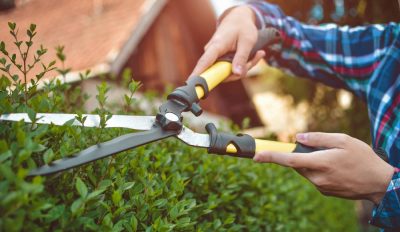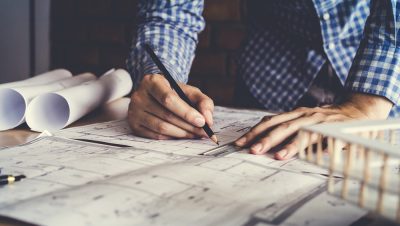- Oneflare /
- Cost Guides /
- Landscaping

How much does Landscaping cost?
$40 - $60 per hour
What's on this page
- How Much Does Landscaping Cost?
- Different Types of Landscapers
- Factors Impacting Costs
- Using timber sleeper steps for landscaping
- Price Estimates for Landscaping
- How to Hire a Landscaper
Read Related Landscaping Articles
How Much Does Landscaping Cost?
Many factors go into a landscaping project. Depending on your vision, the cost can vary from hundreds to thousands of dollars. The standard hourly rate usually falls between $40 to $55.
Landscaping Costs Around Australia
The average cost of landscaping in Australia will vary according to location. Expect to pay 5% to 10% of your home’s worth when upgrading patios, hardscaping and more than just maintenance of groundwork. Here is an average of landscaping costs when using area appraised homes as a guide.
| State/Territory | Averaged Reported Landscaping Costs |
| New South Wales | $20,000 – $44,550 |
| Victoria | $20,000 – $40,000 |
| Queensland | $17,000 – $34,000 |
| Australian Capital Territory | $20,000 – $40,000 |
| Western Australia | $17,000 – $35,000 |
| Northern Territory | $15,000 – $30,000 |
| Tasmania | $12,500 – $30,000 |
| South Australia | $15,500 – $30,000 |
Different Types of Landscapers
It is challenging to get an exact estimate on landscaping because of the different types of work that is required outdoors. Everything from pools to flowers is considered as landscaping. Having a specific project in mind can better help determine the cost of landscaping.
Landscape Designers
A landscape designer presents different options for how to make your structures blend in with nature. Their job is to keep the space functional as well as aesthetic to homeowners and visitors.
Landscape Architects
A landscape architect works with more complex situations such as:
- Irrigation and drainage
- Outdoor structures
- Sloping ground
- Retention walls
Landscapers
Landscapers have experience in performing the actual work with the ground. They can adjust the earth to become better suited for garden projects or in preparation for structures or irrigation systems. The main goal is to create or rework an area that is suitable for your vision.
Landscape Construction Crews
Landscape construction crews work with concrete, wood and stone to build hardscape projects. While construction is their primary objective, following the flow of landscape blueprints is key.
Horticulture Specialists
Horticulture specialists work mainly with living plants, bushes and flowers. Placement, choice of weather-specific plants and overall balance to an area, is their job. Without selecting the proper height, distance and heartiness of plants, a landscaping job can be a disaster.
Gardeners
Gardeners are essential in keeping landscaping well-maintained. Their job is to:
- Prune
- Add plants where needed
- Clean away weeds
- General maintenance
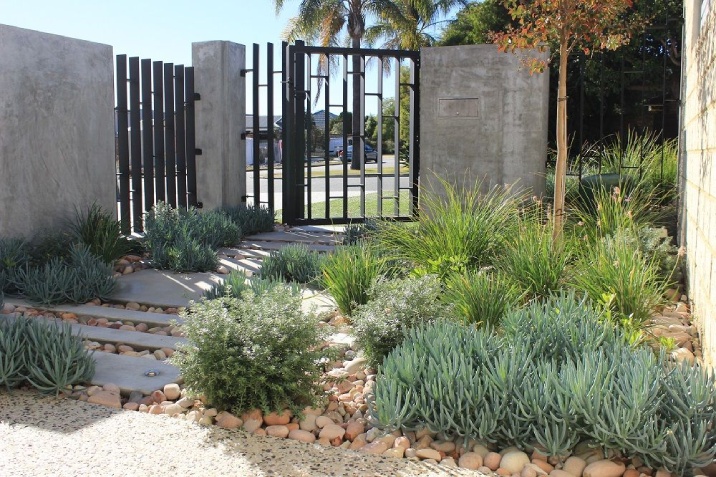
Low-maintenance garden with pavers. | Source: Springgreen Landscapes
Factors Impacting the Cost of Landscaping
Not all landscaping projects are as cut and dried as creating a blueprint and getting the job done. Many factors can arise that can have an impact on the original landscaping prices. For example, most soils are not suitable for raising plants where new construction has just taken place. Testing soil and adding nutrients may be necessary before starting a landscaping project. A garden landscaping cost may have to be adjusted after a soil sample has been taken.
Hardscapes may have to be relocated if they are found to be directly above pipes or electrical wires that have been buried. City or area regulations may also prevent certain types of construction. It pays to do the proper research on the ground and rules of an area before giving a price.
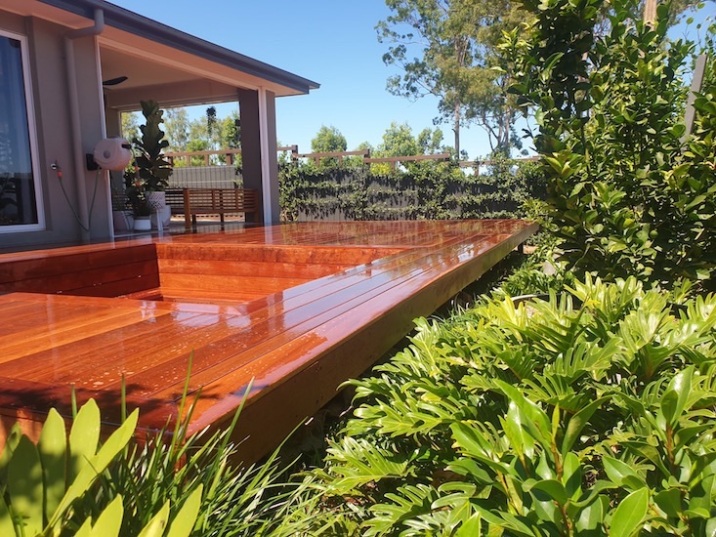
New deck surrounded by green shrubbery. | Source: Jsc Landscape Solutions
Moreover, landscaping supplies also impact the overall cost. Landscaping supply retailers like Neways Landscaping can provide quality services and materials at competitive rates. When creating a new lawn area, using popular and hardy lawn seeds like Hortico Tough and Drought Hardy Lawn Seed and Garden Basics Lawn Seed are perfect for those who want a drought-resistant and long-lasting lawn.
Other factors to consider in your landscaping project include irrigation systems to help keep your garden watered, garden lighting to highlight your outdoor space at night, and softscapes, which may include plant beds, shrubs, and trees. If you need help installing an irrigation system, look no further than garden hose connectors, readily available in most stores.
Using timber sleeper steps for landscaping
One great way to add beauty and functionality to your backyard is by incorporating timber sleeper steps. They can enhance the aesthetics and functional aspects of both vegetable and flower gardens, driveways, garden paths, and more. Before choosing the type of sleeper steps you want, it’s essential to understand the pros and cons of the different materials available.
Hardwood Sleepers vs. Treated Pine Sleepers:
Hardwood sleepers offer a rich, natural look, but the trade-off is that they come with a higher price point. Also, ensure you check the wood is sustainably sourced. On the other hand, treated pine sleeper steps are affordable and commonly used for landscaping projects, and are readily available at most hardware stores. Treated pine sleeper steps come with the added benefit of being resistant to decay and insects. However, they may not last as long as hardwood and will require regular maintenance.
Cypress Sleepers:
Cypress sleepers used to be a sought after sleeper material choice for its durability and resistance to rot. Since its popularity, however, Cypress sleepers are rarely sold without being treated, so strive to source a sustainably-sourced and chemically-treated cypress option. Although they come at higher price points than other options, they can last for many years with proper care.
Treated Pine Vegetable Garden CSIRO:
If you’re looking to construct a raised vegetable garden bed, treated pine sleepers are a popular option. They are affordable and relatively easy to work with. However, there are concerns about chemical contamination from the wood treatment method which can get absorbed into the soil and affect growing crops. The CSIRO recommends using non-treated timber such as ACQ or copper azole as a safer alternative. Additionally, lining the inside of the treated pine with thick plastic lining will act as a barrier against any chemicals potentially leaching into the soil.
Railway Sleeper Driveway:
Railway sleeper steps are another popular landscaping material that can be used for a variety of projects. They offer durability, natural wood aesthetics, and come in different lengths, widths, and thicknesses. Railway sleepers can work well for driveways as they provide a stable base for cars to drive on. However, keep in mind that they will require more regular maintenance than concrete or asphalt driveways.
When incorporating timber sleeper steps into your landscaping project, the key considerations are durability and aesthetic appeal. These steps are versatile and can be used in many areas of your yard, including designing garden beds, steps, and retaining walls.
Key Considerations:
- Make sure you purchase sustainably-sourced timber sleeper steps, particularly for hardwood options.
- Consider environmental factors like soil contaminants, planter-lined toxicity, and climate considerations.
- Regular maintenance is necessary to keep any timber sleeper steps in excellent condition.
- For vegetable garden beds, avoid treated pine sleeper steps if possible, as it can contaminate the soil.
In conclusion, Timber sleeper steps offer a versatile, durable, and elegant landscaping solution. Whether using hardwood, treated pine, cypress, or railway sleepers, your landscaping requirements can be met effectively by careful consideration of the factors listed above. If you’re looking to add natural and rustic style to your yard, choose timber sleeper steps and create a beautiful and functional outdoor space.
Price Estimates for Different Types of Common Landscaping Jobs
Paving
Expect to pay $40 to $65 per square metre of concrete pavers for installation. Limestone is a little more expensive at $45 to $75 per square metre.
Decking
The average cost of building a deck in Australia is between $3,400 and $6,500. The difference in price comes from the square footage and the type of materials used. Raised decking, building on a slope and using hardwood as opposed to composite can make a massive difference in the cost of decking.
Retaining walls
A retaining wall can involve lots of complicated formwork. Curves and decorative finishes can bump up the price to over $250 per square metre. An average straight wall may cost $150 per square metre.
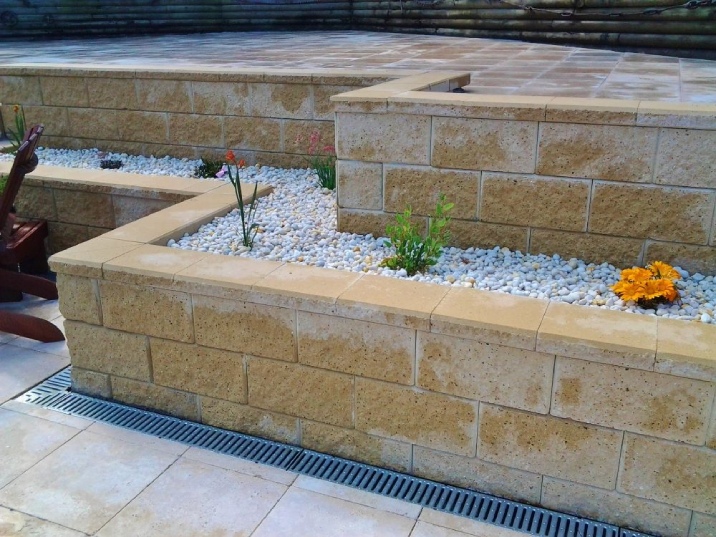
A sandstone retaining wall with garden bed. | Source: Port Maquarie Paving
Patio
A patio can be a great way to entertain friends and family in your backyard. On average a patio can cost between $35 and $75 per square metre.
Swimming pool landscaping
Many people choose to add customized landscaping to their in-ground swimming pools. Simple or lavish dictates the price that one will pay on swimming pool landscaping.
Lawn installation
Many landscapers will also have experience in laying down new natural or artificial turf. The average cost of laying turf is dependent on the type, size and labour involved with the project. Expect to pay between $10 and $100 per square metre.
Gardening
As mentioned, landscapers are often required to conduct both landscaping duties as well as garden maintenance duties. The garden landscaping cost will vary depending on the type of work conducted. Expect to pay between $50 and $150 for general maintenance and pruning/hedging jobs.
A gardening quick tips:
Consider using Koppers logs if you’re looking for durable and long-lasting sleepers for your garden bed. These treated timber logs have been specially designed to resist decay, insects, and fungal decay, making them an ideal option for outdoor projects. To join the sleepers, there are a few tips to remember. First, ensure that the ends of the logs are cut at a 45-degree angle to create a strong joint. Second, use galvanized bolts or planter screws to secure the logs together, pre-drilling the holes beforehand. Finally, make sure to add a layer of gravel or sand beneath the logs to prevent them from sinking into the ground over time. By following these tips, you can create a sturdy and long-lasting garden bed that will stand the test of time.
Landscape designs
The average cost of landscaping designs can be anywhere from $850 to over $6,000. The amount of space and the number of projects involved can have an impact on the price.
Softscaping
Softscaping involves levelling the ground, removal of soil, prepping the soil and planting. A landscaper may charge by the hour or by the job. Hourly rates range from $55 to $70. A complete backyard landscaping cost for adding new plants, trees and lawn on an empty backyard could well be $6,000.
Hardscaping
Hardscaping is the most expensive of all landscaping. It takes several qualified construction and landscape workers to prepare and create a permanent wall, pool or structure. These costs can run up to 10% of your home’s worth. The upside is that elaborate hardscaping and landscaping can raise the value of your property by 6% to 7%.
Backyard makeovers
The backyard landscaping cost can vary according to the removal of trees, installing new lawns or just adding plants. The average backyard landscaping cost for horticulture only can run $6,000. Added features like lighting or planting new trees could drive up the price.
Ponds and water features
Ponds and water features can be part of a backyard makeover but will cost significantly more. Just like excavating for a pool, a pond requires permits and planning. Expect to add $9,000 to $25,000 if a pond or water features are included to landscaping.
How to Hire a Landscaper
Making improvements to your landscape is a major decision to make. You are expecting to see much of the project reflect in your home’s worth. For this reason, you need to be careful in your selection of hiring a landscaper. These details should be crystal clear before signing a contract.
Proof of Insurance and Licensing – Avoid businesses that say they have insurance and licencing but cannot supply you with the proper paperwork.
Portfolio of past work – Ask to see a copy of past work completed in your area. A proud landscaper will have pictures and addresses of their actual completed work.
Permits and planning – Ask to see copies of permits and detailed plans of the job that has been quoted. Without a plan, the job could begin to go sideways in very little time.
How to Create an Accurate Estimate
In order to receive an accurate estimate for landscaping, everything needs to be transparent. Avoid making changes to landscaping requirements, locating possible pipes and wires underground, and pricing all material and plants in advance. An estimate is only as good as the materials you supply your landscaper.
Licensing and Qualifications
| State and Territory | Landscaping Licencing Details |
| NSW | Landscaping Licence for jobs valued over $200; Structural Landscaping Licence for any paving, retaining walls or pergolas |
| VIC | Builders Registration Card for jobs valued over $10,000 |
| QLD | Landscaping Licence for jobs valued over $3,300; Structural Landscaping Licence for any paving, retaining walls or pergolas |
| SA | Building Work Contractor Licence |
| TAS | Trade Licence; Accredited builder necessary for jobs valued over $5,000 |
| WA | No licence required |
| NT | No licence required |
| ACT | No licence required |
How to Save Money Hiring a Landscaper
You do not have to cut corners to get a professional job from a landscaper. However, there are a few areas that may be reworked to keep the cost down. These can include:
- Double-checking if demolition or excavation is included in the quote
- Find materials during warehouse sales or before landscaping begins
- Share your vision with your landscaper, so you’re both on the same page and avoid costly changes in the future
* The cost data is based on Oneflare and third-party sources
Universal Column vs Universal Beam: What's the Difference?
Real Oneflare Customer Quotes
Natalie's Landscaping Job
Job type
Turfing
Size of land
4.5m flat rectangular ground
Timeframe
Needed artificial turf urgently
$1500inc. gst
Quoted by Synthetic And Outdoor Solutions
Mariana's Landscaping Job
Job type
Retaining wall
Height
50cm to 60cm
Length
10 metres
$3000inc. gst
Yvette's Landscaping Job
Job type
Garden renovation
Job details
Garden bed to be dug and weed mat put down
Other
Edging and pebbles put in
$250inc. gst
Quoted by Garden Bae
